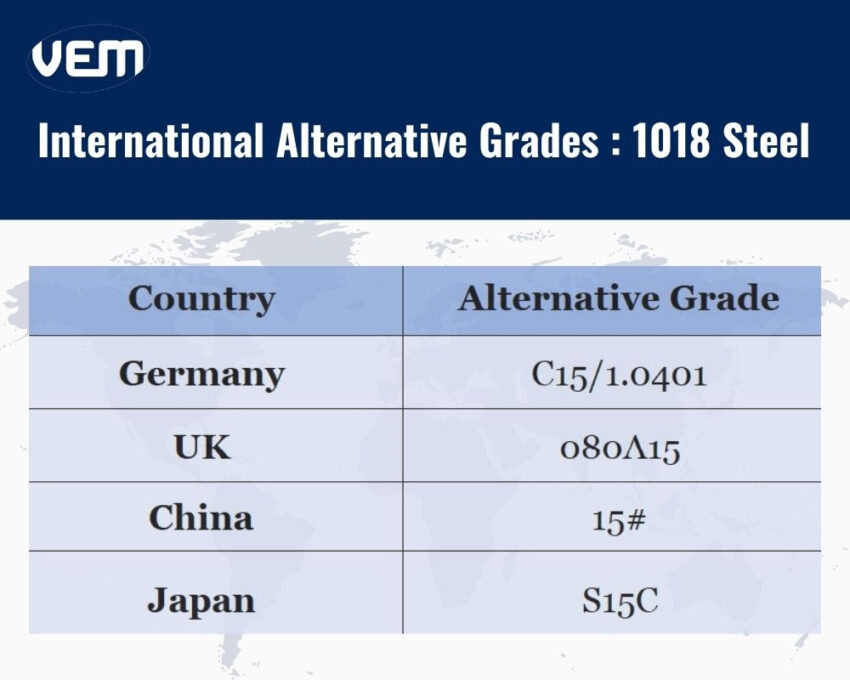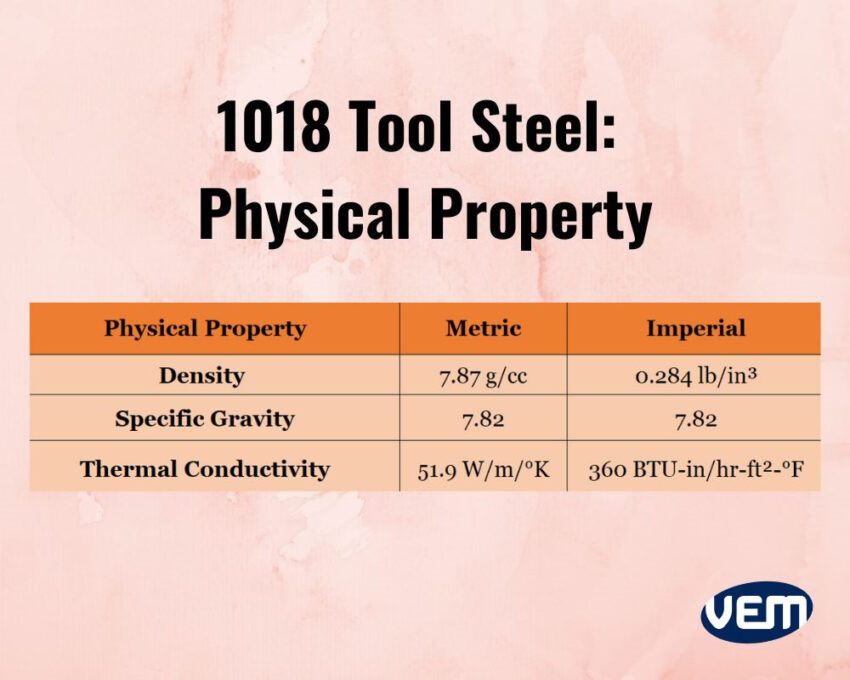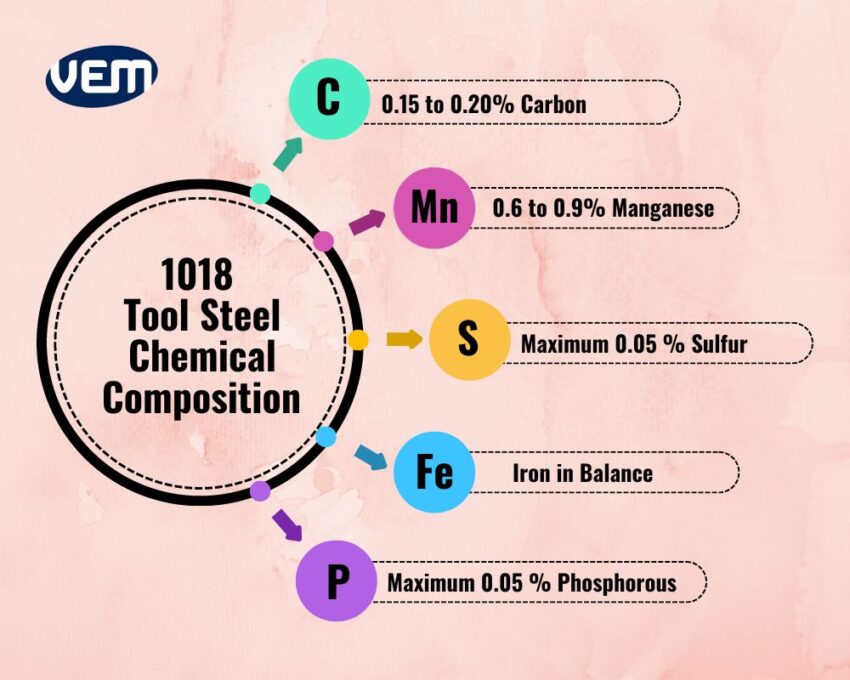

AISI SAE 1018 Steel is a low-carbon steel that features various conventional steel characteristics, such as strength, flexibility, and comparatively easy machining. 1018 tool steel is a dependable mild carbon steel that demonstrates a balanced set of properties and is thus, incorporated for various manufacturing requirements.
AISI SAE 1018 steel is one of the commonly employed and popular low-carbon steels that is typically used as carburized steel. In this article, we discuss 1018 Tool Steel to understand why it’s a reliable and versatile steel of choice, its various characteristics, and its role in manufacturing.
AISI SAE 1018 steel is a mild, low-carbon steel. It’s known for its ease of manufacturability and excellent weldability. 1018 Steel is a great balance of toughness, strength, and ductility. It is also considered to be one of the best steel for carburized parts as it produces a uniform and harder case.
Low-carbon steel is a type of steel that has less than 0.25% carbon content. It’s also referred to as mild steel due to its low strength, low hardness, and softness. A low carbon steel consists of some ordinary carbon structural steel and some high-quality carbon structural steel.
A low-carbon steel’s annealed structure consists of ferrite and a small amount of pearlite. It’s characterized by low strength and hardness, a good level of toughness and plasticity.
Its mechanical properties are not exceptionally unique but it can be easily formed, machined, welded, and fabricated. As a low-carbon steel, it demonstrates a balanced combination of ductility, strength, and flexibility without having the surface issues that are often found in higher-carbon steels. Since it is extremely weldable, it further adds to the versatility of the steel.
It’s an excellent choice of steel when moderate corrosion resistance is required. You should note that it should only be used in applications where severe corrosion is not a major concern.
It’s the best steel for carburized parts as it can be hardened by carburizing and other surface-hardening methods. 1018 tool steel can attain surface hardness to HRC 58 by carburisation.
When compared to higher-strength alloys, 1018 tool steel is cost-effective. Its versatility when combined with affordability makes 1018 tool steel a practical choice for various manufacturing applications.
1018 tool steel demonstrates a good tensile strength but it is not suited for high-stress environments. If greater strength is required, then higher alloy steels are better suited for heavy-duty applications.
You should also note that 1018 tool steel isn’t a free-cutting steel which means it doesn’t contain free-cutting elements that are typically incorporated to improve the material’s cutting performance.
Tool steel is named as per two major institutions in the United States: AISI, abbreviated for the American Iron and Steel Institute, and SAE, abbreviated for the Society of Automotive Engineers.
AISI and SAE have jointly developed a set of steel grade numbering systems which is referred to as UNS, abbreviated for Unified Numbering System. The UNS for 1018 Tool Steel is UNS G10180.
AISI 1018 or SAE 1018, are both 1018 steel. In the case of 1018 tool steel, the first number i.e. 1 indicates that the steel is Carbon. The second number i.e. 0 indicates that there are no main alloy elements, and the last two numbers i.e. 18 indicate that the steel consists of 0.18% Carbon.

1018 tool steel is representative of mild steel, and internationally, has similar grades. These grades are not the same as 1018 tool steel but are similar in element and composition and thus, the specific application must comply with the country standards. The equivalent grades of 1018 tool steel of some countries are enlisted in the following infographic:

1018 Steel can be manufactured into various shapes that range from angle steel, channel steel, steel pipe and plate, to round and square steel, etc. You should note that it can also be processed as required into various sizes of rings, tubes, shafts, and other complex shapes.
1018 steel is available both in imperial and metric sizes thus, they can meet an array of requirements of various industries.
AISI 1018 steel has good hot-forming performance. 1018 tool steel can be deformed by hot rolling and forging process through pressure. This helps to eliminate casting defects and improve the structure and the mechanical material properties.
The annealed structure of 1018 steel contains ferrite and a small amount of pearlite. This composition reduces the strength and hardness, but its plasticity and toughness are better. It can be cold-formed by crimping, bending, stamping, and cold drawing. Thus, 1018 steel has a good cold-forming performance.
1018 tool steel is known for its excellent physical properties. It’s easily machinable thus, enabling manufacturers to easily fabricate and shape. The cold-forming performance of the steel enables flexibility in manufacturing.
It exhibits excellent durability and weldability. It also demonstrates good ductility which further ensures that it can handle deformation without breaking.

1018 tool steel demonstrates a balanced set of mechanical properties. The tensile strength is between 380 MPa and 540 MPa and the yield strength ranges between 310 MPa to 420 MPa.
It demonstrates good ductility by featuring an elongation at a break of about 21-23%. Its high thermal conductivity supports efficient heat treatment, and its low thermal expansion rate ensures stability across various temperatures.

AISI SAE 1018 Tool Steel is a low-carbon steel. It’s composed of 0.15 % to 0.2 % Carbon with 0.6 % to 0.9% manganese and up to 0.05% phosphorus, 0.05% Sulfur, and Iron in balance. This chemical composition gives the steel excellent weldability.

The heat treatment process of 1018 tool steel is very structured and enables manufacturers to achieve distinct material properties. Let’s understand heat treatment for 1018 tool steel further:
The general hardness of SAE AISI 1018 tool steel under normalized conditions or without heat treatment is between 120-150 HB. If higher hardness is required, then the same is achieved by carburizing the steel. After carburization, the surface hardness of the steel can reach 56HRC or more.
Since SAE AISI 1018 steel is low-carbon steel, it’s extremely suitable for carburization. The carburized 1018 tool steel not only has a high surface hardness but also good wear resistance, and core toughness.
Carburized 1018 tool steel is apt for manufacturing wear-resistant parts that can undertake small impact loads such as small shafts, and piston pins.
Correct machining techniques are essential for manufacturing high-quality parts to ensure successful and efficient machining. Machining imparts a fine finish to the steel.
Machining 1018 tool steel is simpler due to its low carbon content. Its composition also makes it easier to work with various machining tasks. The most common machining processes are high-speed cutting tools such as drilling, boring, milling, and turning.
1018 tool steel is easy to weld as it has a low carbon content, thus, making it suitable for a wide range of welding applications. It can be instantly welded through all conventional welding processes such as oxyacetylene, gas, resistance, and submerged melt welding. However; welding isn’t recommended if the steel is carbonitrided or carburized.
During the welding procedure, low-carbon welding electrodes are recommended. You should note that post-heating and preheating are not necessary.
AISI SAE 1018 Steel is a low-carbon steel that’s reliable and versatile in its applications. It is crucial to have a comprehensive understanding of the various types of steels, their characteristics, and their properties to create a well-designed mold.
VEM-Tooling has extensive experience of over 20 years in manufacturing high-quality plastic parts and building mold design. Our team of design experts and engineers can guide you with the correct steel for your manufacturing solution.